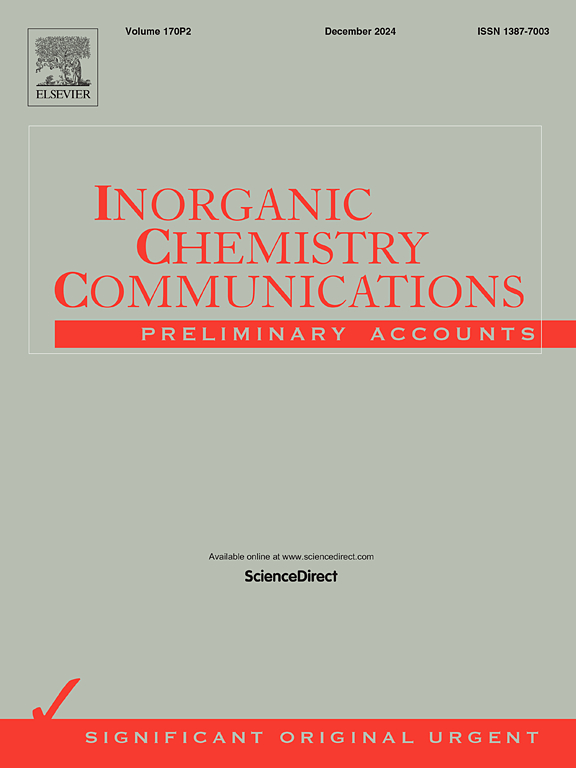γ-氧化铝/壳聚糖/CeO2/SrO纳米水凝胶的设计
IF 4.4
3区 化学
Q1 CHEMISTRY, INORGANIC & NUCLEAR
引用次数: 0
摘要
开发高效和规范的药物输送系统是改善医疗结果和减少医疗保健副作用的关键进步。在这方面,我们通过湿化学技术形成了由γ-氧化铝、壳聚糖、氧化铈和氧化锶(γ-Al/CS/CeO2/SrO)组成的新型纳米水凝胶体系。利用FTIR光谱、紫外可见光谱、Zeta电位分析、PXRD、SEM、BET分析、PZC测定等技术对合成的纳米水凝胶载体的化学结构、光学性质、电荷、尺寸、形状、比表面积、pH等进行了表征。γ-Al/CS/CeO2/SrO纳米载体的BET分析表明,其比表面积为9.195504 × 101 m2/g。XRD证实CeO2/SrO纳米颗粒和纳米水凝胶的平均晶粒尺寸分别为10.3 nm和78.9 nm。紫外可见光谱显示带隙为5.58 eV。采用动态光散射(DLS)对左氧氟沙星(LFX)负载的γ-Al/CS/CeO2/SrO纳米体系的粒径(0.1 μm)进行了分析。LFX是加载和释放研究的模型药物,在酸性、磷酸盐缓冲盐水(PBS)和碱性介质中分别达到64%、90%和78%的最大加载效率。FTIR光谱在869 cm−1处有明显的C-F拉伸峰,zeta电位从−7.13 mv变化到+0.33 mv,表明左氧氟沙星已成功加载到纳米水凝胶体系上。在酸性、磷酸盐缓冲盐水和碱性介质中,释药率最高分别为45.8%、79.5%和19.6%。利用零阶、一阶、Higuchi、Hixson Crowell、Korsmeyer Peppas、Peppas Sahlin等不同的动力学模型对药物释放谱进行分析,确定最合适的药物释放模型。Peppas Sahlin和零级模型的R2分别为0.9678和0.9642,是表征左氧氟沙星控释最准确的模型。Korsemeyer Peppas模型显示扩散释放指数n值为0.926(其中0.45 <;n & lt;1.0),表明药物释放机制遵循异常(非菲克式)扩散,表明扩散和溶出过程都影响药物释放。这些发现突出了所制备的γ-氧化铝/壳聚糖/CeO2/SrO纳米水凝胶作为一种具有控释特性的药物递送纳米载体的潜力,为未来的研究和应用铺平了道路。本文章由计算机程序翻译,如有差异,请以英文原文为准。

Design of γ-alumina/chitosan/CeO2/SrO nanohydrogel for levofloxacin delivery
Developing efficient and regulated medication delivery systems is a crucial advancement for improving medical outcomes and reducing side effects in healthcare. In this regard, we have formed a novel nano hydrogel system made of gamma-alumina, chitosan, cerium oxide, and strontium oxide (γ-Al/CS/CeO2/SrO) through wet chemical techniques. The chemical structure, optical properties, charge, size, shape, surface area, and pH of the synthesized nano hydrogel carrier were characterized using techniques such as FTIR spectroscopy, UV–visible spectroscopy, Zeta potential analysis, PXRD, SEM, BET analysis, and PZC determination. The BET analysis of the γ-Al/CS/CeO2/SrO nanocarrier indicated a specific surface area of 9.195504 × 101 m2/g. XRD confirmed the average crystalline sizes of CeO2/SrO nanoparticles and the nano hydrogel as 10.3 nm and 78.9 nm, respectively. UV–visible spectroscopy showed a band gap of 5.58 eV. The size (0.1 μm) of the levofloxacin (LFX) loaded γ-Al/CS/CeO2/SrO nanosystem was analyzed using dynamic light scattering (DLS). LFX was the model drug for loading and release studies, achieving maximum loading efficiencies of 64 %, 90 %, and 78 % in acidic, phosphate buffer saline (PBS), and basic media, respectively. A distinct peak corresponding to the C–F stretch was observed at 869 cm−1 in the FTIR spectra, and the zeta potential changed from −7.13 to +0.33 mv, indicating that levofloxacin had been successfully loaded onto the nano hydrogel system. The highest percentage of drug release recorded was 45.8 %, 79.5 %, and 19.6 % in acidic, phosphate buffer saline, and basic media, respectively. Different kinetic models, including zero order, first order, Higuchi, Hixson Crowell, Korsmeyer Peppas, and Peppas Sahlin, were utilized to analyze the drug release profile to identify the most suitable one. The Peppas Sahlin and Zero order models, displaying R2 values of 0.9678 and 0.9642, respectively, were the most accurate models for characterizing the controlled release of levofloxacin. The Korsemeyer Peppas model revealed a diffusion release exponent “n” value of 0.926 (with 0.45 < n < 1.0) in the basic medium, indicating that the drug release mechanism followed anomalous (non-Fickian) diffusion, suggesting that both diffusion and dissolution processes influence the release. These findings highlight the potential of the developed γ-alumina/chitosan/CeO2/SrO nano hydrogel as a drug delivery nanocarrier with controlled release characteristics, paving the way for future research and applications.
求助全文
通过发布文献求助,成功后即可免费获取论文全文。
去求助
来源期刊

Inorganic Chemistry Communications
化学-无机化学与核化学
CiteScore
5.50
自引率
7.90%
发文量
1013
审稿时长
53 days
期刊介绍:
Launched in January 1998, Inorganic Chemistry Communications is an international journal dedicated to the rapid publication of short communications in the major areas of inorganic, organometallic and supramolecular chemistry. Topics include synthetic and reaction chemistry, kinetics and mechanisms of reactions, bioinorganic chemistry, photochemistry and the use of metal and organometallic compounds in stoichiometric and catalytic synthesis or organic compounds.
 求助内容:
求助内容: 应助结果提醒方式:
应助结果提醒方式:


